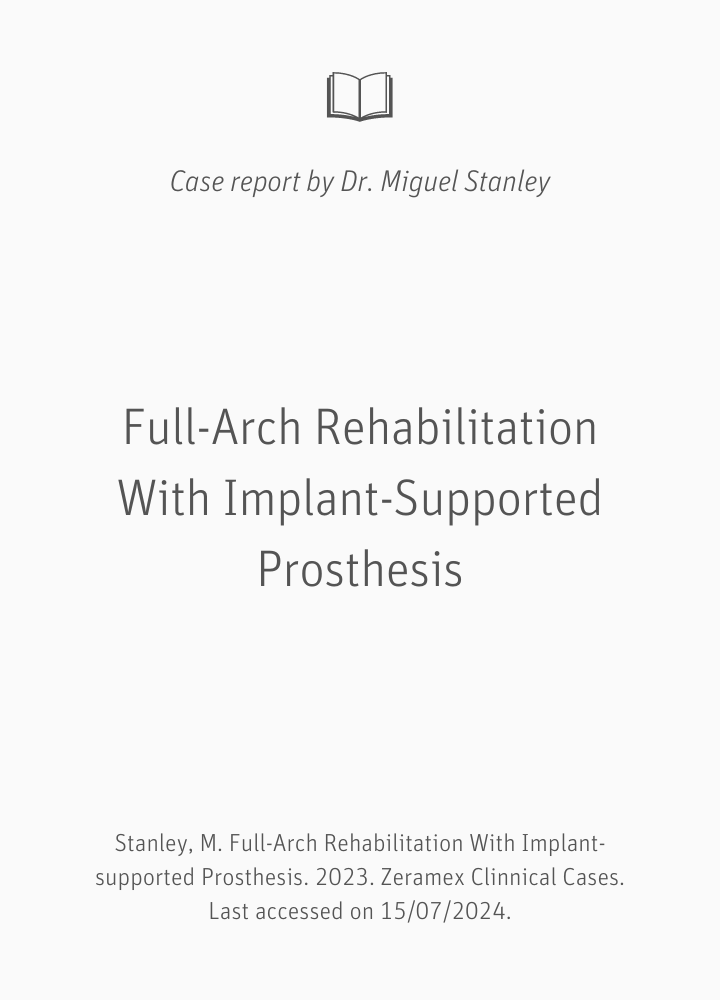Full-arch restoration on zirconia implants
Case report by Dr. Miguel Stanley

Stanley, M. Full-Arch Rehabilitation With Implant-supported Prosthesis. 2023. Zeramex Clinical Cases. Last accessed on 15/07/2024.
Introduction
Terminal dentition can be very painful for patients. The term refers to patients who have lost all or most of their natural teeth. Two-piece implants made of high-performance ceramics are increasingly becoming the focus of clinical application in such cases due to their biological and material properties. No metallic corrosion, less plaque build-up and better biological compatibility of zirconia ceramics compared to titanium make ceramic implants a favoured treatment method for patients with metal intolerance.
This case report documents a full-arch rehabilitation with the aid of an implant-supported prosthesis in a 62-year-old female patient with metal hypersensitivity.
Surgical phase
Pre-implantological rehabilitation of the maxilla was performed prior to implant placement. Six Zeramex XT implants were placed in the maxilla to support the prosthesis. The implants were placed according to the manufacturer's surgical protocols. The healing time was approx. 6 months.
Prosthetic phase
After successful osseointegration, the implants were uncovered. The temporary PMMA restoration (Fig. 5) was used to support the modulation of the gingiva. The customised abutments and the prosthesis were fabricated using CAD/CAM technology. The final restoration was then fabricated (Fig. 6-7)

Figure 1: Terminal dentition in a 62-year-old patient

Figure 2: Implantation

Figure 3: Provisional restoration

Figure 4: Individual abutments

Figure 5: Temporary PMMA restoration

Figure 6: Implant-supported restoration

Figure 7: Final treatment result
Discussion
The new S3 guideline ‘Material incompatibilities with dental endosseous implants’ shows the continuing relevance of the topic today. This recommends that dental ceramic implants can be considered as a treatment option if a localised titanium-related inflammatory reaction is suspected. However, the cause of an intolerance reaction may also be the metals or impurities present in the superstructures or alloys.
Despite all the advantages of titanium as an implant material, the literature shows clear advantages of zirconium dioxide. For example, the high-performance ceramic exhibits lower plaque accumulation and lower bacterial adhesion (Scarano et al. 2004, Ichikawa et al. 1992). In addition, a lower thickness of the deposited biofilm was found with zirconium dioxide (Roehling et al. 2016). Circulatory blood flow to the surrounding soft tissue in zirconia ceramics is more similar to that of natural teeth and is significantly reduced in titanium (Kajiwara et al. 2015). Better circular blood flow is known to mean healthier gingiva, which not only leads to better aesthetic results (Tartsch 2018). In the 3- to 5-year results, zirconia implants showed the same marginal bone loss as titanium implants (Cionca N, Mombelli A et al. 2016, Spies et al. 2018, Janner et al. 2018). In the study by Roehling et al. (2018), this is even less than with titanium implants. This trend is confirmed by preclinical studies and clinical experience (Tartsch 2018). No peri-implantitis was observed with ceramic implants (Cionca N, Mombelli A et al. 2016, Spies et al. 2018, Janner et al. 2018, Roehling et al. 2018).
Ceramic implants are definitely on the rise and are becoming an increasingly popular treatment option in the White Clinic. They are suitable for patients who are sensitive to metal or are looking for a metal-free alternative. It is essential to maintain a good vitamin D level and to clean the bone very well before insertion.
References
Cionca N, Mombelli A et al.: Pro-inflammatory cytokines at zirconia implants and teeth. A cross-sectional assessment. Clin Oral Investig (2016).
Janner S, Gahlert M, Bosshardt D, Roehling S, Milz S, Higginbottom F, Buser D, Cochran DL: Bone response to functionally loaded, two-piece zirconia implants: A preclinical histometric study. Clin Oral Implants Res 29 (3), 277-289 (2018).
Kajiwara Net al.: Soft tissue biological response to zirconia and metal implant abutments. Implant Dentistry 24 (1), (2015).
Roehling, S.; Schlegel, K.A.; Woelfler, H.; Gahlert, M. Performance and outcome of zirconia dental implants in clinical studies: A meta-analysis. Clin Oral Implants Res 2018, 29 Suppl 16, 135-153.
Roehling S et al.: In vitro biofilm formation on titanium and zirconia implant surfaces. | Periodontol 88 (3), 298-307 (2016).
Roehling S, Gahlert M, Janner S, Bo Meng, Woelfler H, Cochran DL: Ligature-induced peri-implant bone loss around loaded zirconia and titanium implants. International Journal of Oral & Maxillofacial Implants, Review process (2018).
Scarano A, Piattelli M, Caputi S, Favero GA, Piattelli A: Bacterial adhesion on commercially pure titanium and zirconium oxide disks: An in vivo human study. J Periodontol 75, 292-296 (2004).
Spies C, Vach K, Kohal RJ, Hämmerle CHF, Jung RE: Three-year analysis of zirconia implants for single-tooth replacement and three-unit fixed dental prostheses. Clin Oral Implants Res 29 (3), 290-299 (2018).
Tartsch J: Keramikimplantate - Exoten oder sinnvolle Erweiterung des Behandlungsspektrums. ZMK 34-11 (2018).
Tartsch J: Komplexe Restauration mit Keramikimplantaten: zweiteilig, metallfrei und verschraubt. Dentale Implatologie und Parodontologie
(2021).
About author
Dr. Miguel Stanley is the founder and clinical director of the world-renowned White Clinic. He is also co-founder of the Slow Dentistry Global Network and Vice President of the Digital Dentistry Society as well as a member of many international scientific and academic organisations. Dr Stanley is an adjunct professor at the University of Pennsylvania (USA) and has lectured in more than 50 countries on topics such as advanced implantology, prosthodontics, complex oral surgery, aesthetics, practice management and ethics, as well as his world-famous ‘No Half Smiles®’ work philosophy. He is one of the first dentists to ever give a TEDx talk and the only one to have hosted a documentary on dentistry for National Geographic. He was recently named one of the top 100 dentists in the world by his peers and one of the ‘32 Most Influential People in Dentistry’ by Incisal Edge magazine.
Haben Sie Fragen zu den Veröffentlichungen oder möchten Sie mehr zum Implantatsystem Zeramex XT erfahren?
Wir begrüssen Veröffentlichungen zum Implantatsystem Zeramex XT. Falls Sie Ihren Fall dokumentieren und veröffentlichen möchten, teilen Sie uns dies bitte via Kontaktformular mit.
Kontaktformular


